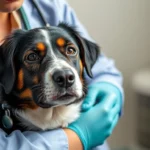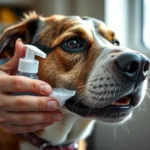
Puppies are often the embodiment of joy and playfulness, but when you notice that your furry friend has developed bald spots, it can be concerning. Understanding the underlying causes of these spots is crucial for ensuring your puppy’s health and well-being. This article will delve into the reasons behind puppy bald spots, how to recognize accompanying symptoms, when to consult a veterinarian, and tips for home care and prevention.
Understanding Puppy Bald Spots
Definition of Bald Spots
Bald spots in puppies refer to areas on the skin where fur is absent, leading to an uneven appearance. These spots can vary in size and may occur in various locations, often around the ears, eyes, belly, or along the back. While some bald spots may be small and isolated, others can be more extensive, affecting larger areas of the body.
Importance of Addressing Bald Spots
Ignoring bald spots can lead to potential health implications for your puppy. Some causes, like infections or parasites, require prompt treatment to prevent further complications. Additionally, bald spots can cause aesthetic concerns and lead to anxiety for pet owners who want to ensure their puppy looks healthy and happy.
Common Causes of Bald Spots in Puppies
Allergies
Puppies can suffer from various types of allergies, which can lead to bald spots. Common allergens include specific foods, pollen, dust mites, and flea bites. Symptoms accompanying bald spots due to allergies may include excessive itching, redness, and inflamed skin.
- Food Allergies: Ingredients such as chicken, beef, or grains can trigger reactions in sensitive puppies.
- Environmental Allergies: Seasonal changes can introduce new allergens, leading to discomfort.
Parasites
Parasites are another leading cause of bald spots in puppies. Common parasites include:
- Fleas: These tiny pests can cause severe itching and hair loss, especially in areas where fleas bite.
- Mites: Conditions like mange, caused by mites, can lead to bald patches and severe itching.
- Ticks: While they are more known for disease transmission, ticks can also cause localized hair loss.
Skin Infections
Both bacterial and fungal infections can lead to bald spots. When the skin barrier is compromised, infections can occur, leading to hair loss.
- Bacterial Infections: Often characterized by redness and pus, these infections can develop from scratching or other skin irritations.
- Fungal Infections: Ringworm, a common fungal infection, can cause circular bald patches and is often accompanied by scaling.
Hormonal Imbalances
Hormonal issues can also contribute to hair loss in puppies. Conditions like hypothyroidism or Cushing’s disease can affect fur growth and lead to bald spots. These imbalances may also cause other symptoms, including lethargy, changes in appetite, and skin texture changes.
Other Medical Conditions
In addition to the aforementioned causes, other medical conditions can lead to bald spots. Autoimmune diseases, for example, can cause the body to attack its own hair follicles, resulting in hair loss. It’s essential to consider these underlying health issues if your puppy is experiencing bald spots.
Recognizing Accompanying Symptoms
Itching and Scratching
If your puppy is experiencing bald spots, it’s important to observe their behavior. Excessive itching and scratching often indicate discomfort. You can assess their scratching patterns to connect it with potential causes, such as allergies or parasites.
Redness and Inflammation
Another critical factor to observe is the condition of the skin. If you notice redness or inflammation around the bald spots, it may indicate irritation or infection. These signs require immediate veterinary attention to prevent further complications.
Changes in Behavior
Changes in your puppy’s behavior can also indicate discomfort or pain. If your otherwise playful puppy becomes withdrawn, restless, or shows signs of anxiety, it could be linked to their skin condition and should be investigated further.
When to Consult a Veterinarian
Signs That Require Immediate Attention
There are specific signs that warrant immediate veterinary attention. If your puppy exhibits severe symptoms such as:
- Persistent scratching leading to open wounds
- Severe redness or swelling
- Signs of infection (pus, foul odor)
- Sudden behavioral changes
It is crucial to seek veterinary care without delay.
What to Expect During a Veterinary Visit
When you consult a veterinarian, they will typically perform a thorough examination of your puppy. Diagnostic procedures may include:
- Skin Scrapings: To check for parasites or fungal infections.
- Allergy Tests: To identify environmental or food-related allergies.
- Blood Tests: To evaluate hormonal levels and overall health.
Based on the findings, your veterinarian will suggest appropriate treatments, which may include medications, special shampoos, or dietary changes.
Home Care and Prevention
Maintaining Skin and Coat Health
Regular grooming plays a vital role in maintaining your puppy’s skin and coat health. Brushing not only removes dirt and loose fur but also distributes natural oils, promoting healthy growth. When grooming, be sure to use products specifically designed for puppies to avoid skin irritation.
Nutritional Support
A well-balanced diet is essential for healthy skin and fur. Ensure your puppy is receiving high-quality food rich in essential fatty acids, vitamins, and minerals. Supplements such as omega-3 fatty acids can support skin health and may help with fur growth.
Environmental Management
To reduce allergens in your home, consider implementing the following practices:
- Keep your home clean by vacuuming regularly and washing your puppy’s bedding.
- Use air purifiers to reduce airborne allergens.
- Maintain a flea prevention regimen to minimize the risk of infestations.
Conclusion
Monitoring your puppy for bald spots is crucial for their overall health. Understanding the various causes, recognizing accompanying symptoms, and knowing when to seek veterinary help can mitigate potential issues. By maintaining proper grooming practices, providing a balanced diet, and managing their environment, you can help ensure your puppy remains healthy and happy.
Frequently Asked Questions (FAQ)
Can bald spots in puppies be temporary?
Yes, some bald spots can be temporary, often resulting from minor irritations or transient allergies. However, if they persist or worsen, consulting a veterinarian is advisable.
Are certain breeds more prone to bald spots?
Certain breeds with sensitive skin, such as Bulldogs or Dachshunds, may be more susceptible to conditions that cause bald spots. Genetic predispositions can play a role in skin health.
What home remedies can help with puppy bald spots?
While some home remedies may soothe skin irritation, it’s essential to consult a veterinarian before trying these. Common remedies include oatmeal baths or coconut oil applications to moisturize dry skin.
How can I tell if my puppy’s bald spots are serious?
Signs that indicate seriousness include persistent itching, swelling, redness, and any discharge from the affected area. If your puppy is also showing behavioral changes, it’s best to consult a veterinarian.
By staying vigilant and informed, you can ensure your puppy remains as healthy and playful as ever, free from the worries of bald spots and other skin issues.









